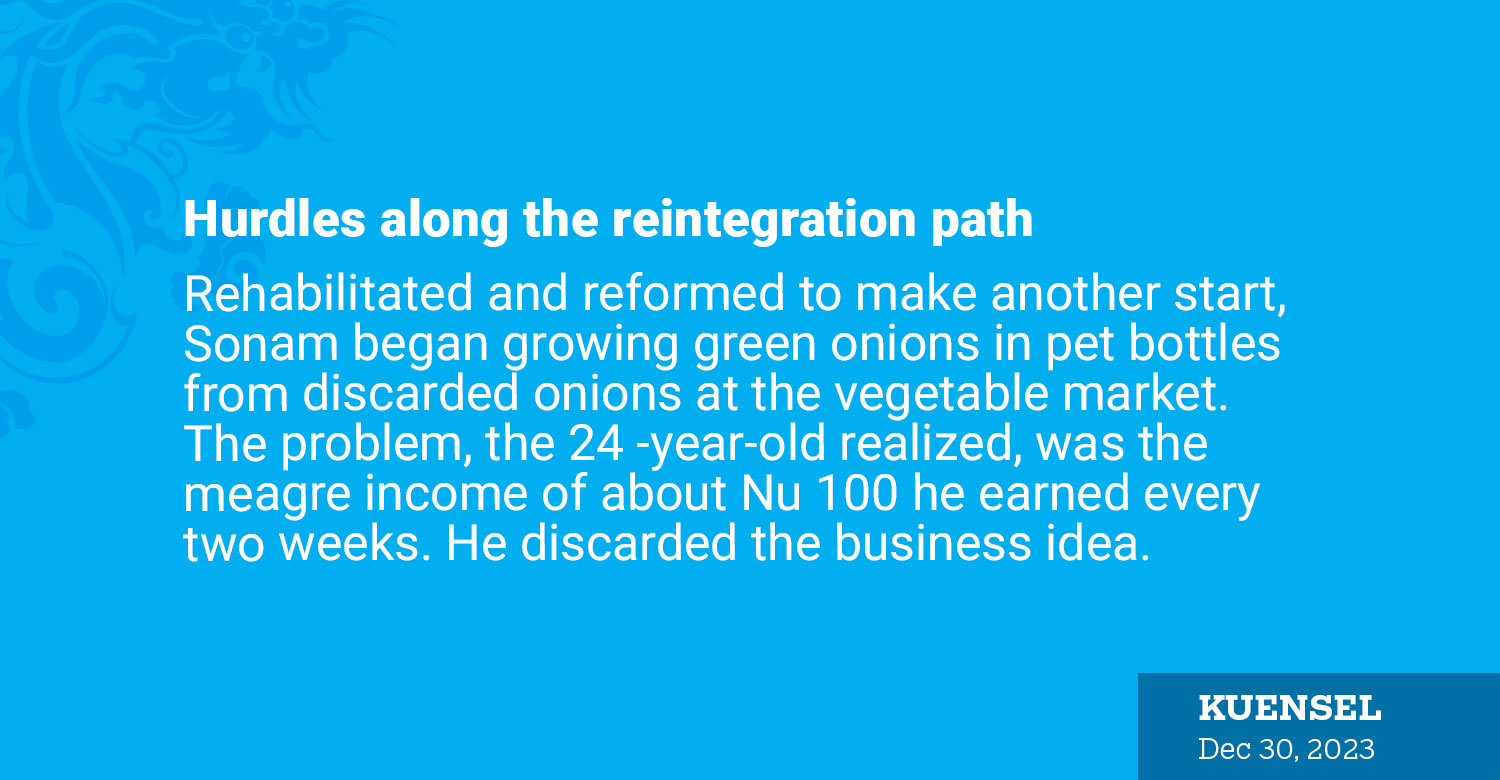Rehabilitated and reformed to make another start, Sonam began growing green onions in pet bottles from discarded onions at the vegetable market. The problem, the 24 -year-old realized, was the meagre income of about Nu 100 he earned every two weeks. He discarded the business idea.
Sonam, a Class 8 drop-out, had limited options.
In 2016, while in grade 6, he was arrested for consuming, and possessing beyond the permissible limit, of the narcotic drug, SP Plus. After being detained for close to a year, he was granted the opportunity to reform and rehabilitate at the Youth Development and Rehabilitation Centre (YDRC), as he was a minor. There, he was allowed to attend school. When he finished serving time, he also completed grade 8.
On returning home, he was eager to continue education, but schools in Thimphu denied him admission as he was a convict. It was immaterial if he was reformed, or rehabilitated.
The society and its systems’ inability to give a ‘second chance’ to children who have come in conflict with the law, have them struggling to be accepted, and accommodated by their parents, family, and the community as a whole.
It mirrors the society’s unflinching stand against children and youth who come in conflict with the law, and an unequivocal warning to youngsters in general to stay away from it. However, whether the deterrence has been effective is refutable given that more children and youth are reportedly arrested for consuming and possessing narcotic drugs, and for committing other offenses.
But the resulting impediment to those who have reached the decision to reform and course-correct, is severe and with far-reaching consequences.
“For a month I did not come out of the house, as I could not face anyone,” said another youth who lives on the outskirts of Thimphu. “It was not pleasant encountering neighbours.”
Finding a job was difficult, for carrying the tag, as he calls it, on the basis of which employers either refused to employ, while others, especially in the construction industry, let them work but refused to pay full.
“Construction sector is comparatively an easy opportunity available for us,” he told Kuensel, being a grade 7 drop-out.
Consequently, in less than two years, he was back at YRDC, for another offense. Of the 60 who came for reintegration on completing the time, eight went back to the centre unable to reintegrate, according to existing data.
Whereas the society have predetermined them as trouble makers, the children come out with hopes of seamless reintegration and a normal life back, says Executive Director of CSO Nazhoen Lamtoen, Thinley Tobgay. The CSO working for children who come in conflict with law finds itself convincing parents, family, and the community members to give a chance to the children who committed an offence but served their time, and have now come to them with renewed hope. They also have to convince schools, training institutes, and potential employers.
This is not to imply though that everyone fit the above narrative. Despite effort from all quarters some youth fail to mend ways and keep oscillating between home and detention. For example, a restaurant opened with much hope for such a youth was found closed and abandoned a week later. Nazhoen Lamtoen, who helped open the restaurant was left wondering with some huge pots and pans, and a celebratory piece of the inauguration by Kuensel.
But on the bright side, as evidence of success stories motivating everyone involved, some of them have become assistant cameramen in the local film industry, or chefs in reputed hotels. When not chopping meat, one such youth composes music in his small music studio (also helped set up by Nazhoen Lamtoen) selling them to local film producers. Some of them went to college, while others graduated from grade 10 and 12.
The multiple agencies involved in an animated effort on reintegration, is a case in point, of treating the symptom rather than the disease, says a lawyer.
Agrees Thinley Tobgay, who says the priority must be on ‘preventing’ children and youth from coming in conflict with the law. And the preventive effort as a whole-of-continuum must begin at home, he added.
Nazhoen Lamtoen’s on-going Helvetas funded activity – the community-initiated child protection program – was designed to nudge parents, family, and community members to take responsibility and ownership of identifying and responding to the risk of their own adolescent children and youth from committing crimes, among others.
The implementation of ‘diversion’ instead of judicial proceedings for child justice, and the progressive reorientation of the law enforcement agency, has helped keep many children and adolescents away from the prison. Now the society must help keep them away from crimes.
Contributed by Bishal Rai
(Identities of the youths mentioned here have been withheld to avoid further discrimination)


